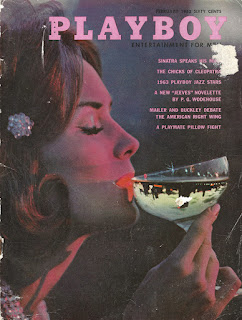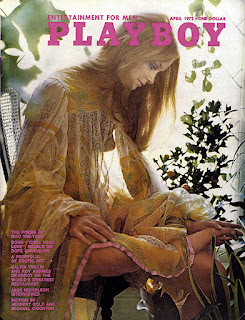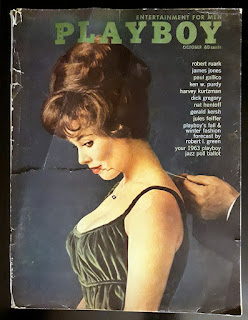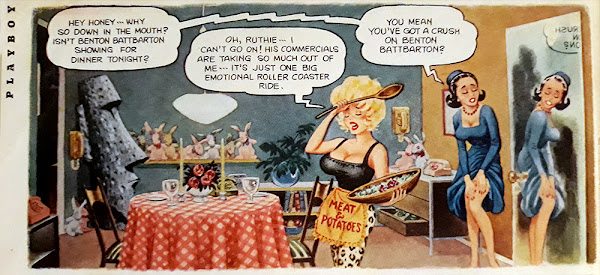Chicken Ranch Central
Friday, May 03, 2024
Friday Night Videos
Chicken Ranch Central
Tuesday, April 30, 2024
Reading Playboy for the articles: February 1963
Highlights: In all honesty, I did not intend this retrospective to become a recap of all the interviews Playboy has published over the decades, but damned if this legendary series hasn't been among the most captivating content in each issue thus far. For February 1963 the interview subject is none other than Frank Sinatra. I've never been a Sinatra fanboy. Having grown up hearing only his work from the latter decades of his life, I thought his talent was way overrated until I heard his early vocals and had my "Ah-ha!" moment. With his Italian/Sicilian background and mob connections, I never took him for much of a deep thinker. Sinatra fans are obviously cursing me now, but the following exchange pretty much blew up my notions of the man:
Playboy: All right, let's start with the most basic question there is: Are you a religious man? Do you believe in God? Sinatra: Well, that'll do for openers. I think I can sum up my religious feelings in a couple of paragraphs. First: I believe in you and me. I'm like Albert Schweitzer and Bertrand Russell and Albert Einstein in that I have a respect for life--in any form. I believe in nature, in the birds, the sea, the sky, in everything I can see or that there is real evidence for. If these things were what you mean by God, then I believe in God. But I don't believe in a personal God to whom I look for comfort or for a natural on the next roll of the dice. I'm not unmindful of man's seeming need for faith; I'm for anything that gets you through the night, be it prayer, tranquilizers or a bottle of Jack Daniel's. But to me religion is a deeply personal thing in which man and God go it alone together, without the witch doctor in the middle. The witch doctor tries to convince us that we have to ask God for help, to spell out to him what we need, even to bribe him with prayer or cash on the line. Well, I believe that God knows what each of us wants and needs. It's not necessary for us to make it to church on Sunday to reach Him. You can find Him anyplace. And if that sounds heretical, my source if pretty good: Matthew, Five to Seven, The Sermon on the Mount. Playboy: You haven't found any answers for yourself in organized religion? Sinatra: There are things about organized religion which I resent. Christ is revered as the Prince of Peace, but more blood has been shed in His name than any other figure in history. You show me one step forward in the name of religion and I'll show you a hundred retrogressions. Remember, they were men of God who destroyed the educational treasures at Alexandria, who perpetuated the Inquisition in Spain, who burned witches in Salem. Over 25,000 organized religions flourish on this planet, but the followers of each think all the others are miserably misguided and probably evil as well. In India they worship white cows, monkeys and a dip in the Ganges. The Moslims accept slavery and prepare for Allah, who promises wine and revirginated women. And witch doctors aren't just in Africa. If you look in the L.A. papers of a Sunday morning, you'll see the local variety advertising their wares like suits with two pairs of pants.In light of the statements above, it's interesting that Sinatra, who was raised Catholic, returned to that faith following the death of his mother. In "The Playboy Philosophy," an editorial by Hugh M. Hefner, we get a bit of insight into the thinking of the day. And by that we get a muddled mix of anti-communist talking points, flag-waving patriotism and a soapbox screed against hypocrisy and censorship. The arts may have stagnated and the U.S. had flirted dangerously with the siren song of socialism in the previous decade, but the country was poised for a renaissance of creativity and prosperity. It may have generated a bunch of heads nodding in agreement at the self-evident truths laid out, but six decades later is comes off as hopelessly naive. Hef and his cronies have absolutely no idea how much turmoil and upheaval await them in the coming years. Kennedy is still president and few people have even heard of Vietnam. In the monthly column, "Playboy After Hours," the author takes on that favorite punching bag of science fiction authors everywhere, the immortal Tom Swift. For the uninitiated, Tom Swift was the title character in a long running series of novels first published in 1910 and continuing (in one form or other) to the present. Swift's adventures are filled with the latest technology and inventions, with the overall theme that progress is always positive. It's borderline science fiction, in that the technologies, though real, are exotic and new. But the reason why Tom Swift is mostly remembered today is for the writing, which is clunky to say the least. This is the aspect of Tom Swift Playboy zeroes in on:
As we slogged "resolutely" through the syntactical swamp of a typically Tom Swiftian tale the other day, we found ourself thrashing about in search of fresh and more fitting dialog for the unlikely adverbs attached like barnacles to nearly every deathless utterance. "'How about a roll in the hay?' said Tom loftily," we heard ourselves muttering. "'I'm afraid you've got the mumps,' said Tom infectiously," we offered then, to no one in particular. "'Isn't anyone going to bid/' asked Tom passively" was our next gem. Clearly, things were getting out of hand. The dialog began to pour out unbidden: "'I'll have a martini,' said Tom dryly." "'The results of my electrocardiogram were reassuring,' said Tom wholeheartedly." "'I'm sure I can dig up a date for you,' said Tom gravely." "'Jayne Mansfield isa remarkable actress,' said Tom figuratively." "'I'm afraid prunes don't agree with me,' said Tom loosely." "'What our ball club needs is a man who can hit 60 homers in a season,' said Tom ruthlessly." "'I detest fairy tales,' said Tom grimmly, 'but I'm quite fond of charades,' he added skittishly."
Other thoughts:
Red Skelton, once a titan of entertainment but mostly forgotten these days, dresses up as his hobo character to pitch for the Sands in La Vegas. This ad just fascinates me--the lush, hyper-saturated colors and contrast gives it an illustrative feel. It's a photograph, but it might just as well be a Norman Rockwell painting--albeit a decidedly off-kilter one. That this exists is amazing. One fashion standout emerges from "The Playboy Advisor," when one desperate soul writes in with this pressing question:I have several cummerbunds that I wear with my one tuxedo, thus adding variety to my appearance at formal social functions. Would it be equally correct to wear an evening waistcoat? --S.G., Cleveland, Ohio. It's not only correct to wear and evening weskit, but currently it's preferrable to the cummerbund, especially with the Continental tuxedo (dinner jacket). The weskit may match the dinner jacket in material and lapels, or you may wish to branch out a bit with tasteful and subdued brocades. Conservative chaps who don't dig brocaded dinner jackets may thus lend a bit of flair and individuality to their monochromatic evening duds.There's also a full-blown article, "From Collar to Cuffs," which bills itself as "a gentleman's guide to shirts and shirtings, styles and colors, and how to select those suitable to you and the proper occasion." It does a deep dive into matching the most flattering collar style to the shape of one's face, discusses 12 (!) basic collar styles and then gives an instructional on how to properly execute two different types of necktie knots. Silly me, I'd always thought of the "Four-In-Hand" as a "half Windsor." I have no idea if any modern ties are long enough to pull off a full Windsor. One wonders where men will find their fashion advice now that Playboy is not longer in print. In desperation, I suppose, they could look to GQ. Finally, there are no fewer than three record club ads in this issue--the Columbia Record Club, the Capitol Record Club and RCA Victor Record Club. These offer the opportunity to obtain six albums for $1.99, five albums for 97¢ or one record for 10¢ (with four more free) respectively. For those readers of Generation X extraction, this brings to mind those halcyon days of Columbia House and BMG Music clubs, where we could get six albums (or cassettes, or CDs) for a dollar with the stipulation of purchasing six more (or whatever arbitrary number they set) in the coming year. If you were like me, dear reader, the bulk of your music collection was comprised of music obtained this way--once the subsequent purchase obligation was fulfilled, I'd immediately cancel my existing membership and sign up again to get that sweet, sweet introductory deal. Kids today have no idea the rush that comes with cracking open that box the postal carrie dropped off full of sweet, sweet music. The fact that there were so many other choices back in the day has me a little envious, to be honest. Now Playing: Webley Edwards Hawaii Calls: Exotic Instrumentals
Chicken Ranch Central
Friday, April 26, 2024
Friday Night Videos
Chicken Ranch Central
Tuesday, April 23, 2024
Reading Playboy for the Articles: April 1972
I mean, sure, all my life I've heard how the 1970s were a fahion trainwreck where poor decisions intersected bad taste on an epic scale. I mean, the first decade of my life was spent living through this decade. But something repeated so reflexively begins to take on an air of cliche, to the point where one is tempted to soften condemnation a bit. Maybe it wasn't that bad. Nope. With a single ad H.I.S. Jeans and Western Shirts confirms everything that's bad about 70s fashion. And just to underscore this isn't a one-off, there are a couple other ads in the issue that underscore unfortunate fashion trends, plus there's an actual article, "Playboy's Spring & Summer Fashion Forecast," that showcases even more egregious fashion faux pases with the indication this is what all the self-respecting lemmings will be wearing the coming season. For the record, at least one male model in the spread looks downright angry at getting stuck wearing a knit wife-beater with embroidered flowers on the front. Not even kidding.
As if to counter the notion that this issue consisted only as a time capsule of regrettable cultural miscues, Playboy turns around and serves up "Seven Poems by Mao Tse-Tung," translated by Nieh Hua-Ling and Paul Engle. I mean, what? The poems aren't romantic affairs by any means, but rather his musings on guerilla warfare and grim ideological determination. For instance:Chingkang Mountain (Autumn 1928)I mean, he's no Shel Silverstein but the man certainly knows how to stay on message. It's an insightful glimpse into the man who would have a profound influence on shaping the 20th century. There's also a Jack Nicholson interview here. He's a star in the aftermath of Easy Rider but not yet become THE Jack Nicholson. Much of the interview is consumed by discussion of taking drugs and various trips Nicholson had experienced, but the following section was interesting, in a "the more things change, the more they stay the same" sense:
Below the mountain, their flags flying
High on the mountain, our bugles blowing:
A thousand circles of the enemy around us:
we still stand unmoved. Defense is deadly, trench and wall,
the strongest fort is our will.
From Huangyangchieh cannon roar,
crying: the enemy runs away in the night.
Nicholson: In fact, in the first and only film I directed--Drive, He Said--I used a number of my old cronies. And I was more than pleased that I was in a position to do so. Playboy:Why was Drive, He Said originally rated X by the Motion Picture Association of America? Nicholson: Because it had frontal nudity and it had someone who was fucking have an orgasm. The orgasm is audible, not visible. The person says, "I'm coming." I'm convinced the rating system is 100 percent corrupt. The censors say they're protecting the family unit in America when, in fact, the reality of the censorship is if you suck a tit, you're an X, but if you cut it off with a sword, you're a GP [PG today].
Other thoughts:
Great googaly moogaly, what the hell is this gonzo monstrosity!? The 70s were absolutely, certifiably nuts but every so often it stumbled upon something so brilliantly ahead of its time that one really has to wonder why we don't all have flying cars like the Jetsons. The bubble house is one of those things. Officially marketed as a Pneudome, a 500 square foot inflatable dome house made of polyvinyl and marked by a Los Angeles design group known as Chrysalis absolutely screams to be one of the centerpieces of a Burning Man bodypaint orgy. Preferrably one with lots of Jack Nicholson's drugs available. I can only assume from the fact that I have never, ever seen this before--despite the fact this thing looks like it is straight out of a 1970s science fiction movie--that the Pneudomes were not a tremendous success on the sales front. I have to wonder what the airflow in one of these was like, and all the furniture inside is presumably non-inflatable. The article earnestly insists that four people--two swinging couples, from the looks of it, as there are no separate bedrooms--can easily carry, inflate and pack up the globular pop-up with minimal effort. I have my doubts. AndI can't help but imagine the whole thing smelling like the inside of a beach ball. But damn, talk about being 50 years ahead of its time, I can just imagine Elon Musk ordering up a thousand of these wannabe Mars habitats for his Tesla factory town outside of Bastrop. The mind boggles. Now Playing: The Gene Rains Group Lotus LandChicken Ranch Central
Tuesday, April 16, 2024
Reading Playboy for the articles: October 1962
Highlights: For me, the standout of this issue is the interview of troubled, troublesome, brilliant and insecure Peter Sellers. Dr. Strangelove and The Pink Panther were still two years in the future. He'd completed 16 films in the previous five years and had garnered considerable attention for his role of Clare Quilty in Stanley Kubrick's Lolita. Enjoying hindsight afforded by the intervening six decades, I found this exchange particularly striking:
Sellers: I'm not a star, because I have no personality of my own. Playboy: Hasn't success enabled you to find your personality? Sellers: Success hasn'e enabled me to find out anything about myself. I just know I can do certian things. If you go too deep into yourself, if you analyze yourself too closely, it's no good for the job. You can either act or you can't. If you analyze your own emotions all the time, and every doorknob you handle, you know, you're up the spout. Playboy: But supposing you were asked to play a character called Peter Sellers, how would you play him? Sellers: What I would do, I'd go to see all my friends. I go to see my acquaintances, and ask them how they see me, ask for their impressions of Peter Sellers. And then I would sift these characterization. That's all I can do, because I am quite unaware of what I am.Oddly, the interviewer is not credited. Was this standard practice for Playboy back in the day? Curious.
Other thoughts: The cover on this one had torn off but I initially thought it was an incorrect match. What I considered the biggest selling points of the issue--Peter Sellers, Arthur C. Clark, Shel Silverstein--weren't mentioned on the cover, but folks like Nat Hentoff, Ken W. Purdy and Gerald Kersh (who I've never heard of) were. Shows how much times, and perspectives, change.
There's a an excerpt from Percival by Chertien de Troyes, "Gawain and the Lady of the Pavilion," presented as a ribald classic, so we know our 1962 readers were well-read when it came to their Arthurian lore. And there's the 1963 Playboy Jazz Poll, which indicates the importance jazz still played in entertainment despite the ascendance of rock and roll. Sadly, the poll itself is torn out, which I suppose means the original owner was passionate enough about music to make his (or her) opinions known to the editors.Finally, the tikiphile in me squeed! when I saw this panel of the long-running Playboy comic, "Little Annie Fanny." She. Has. A. Moai. Life goals.
Now Playing: The Rolling Stones RewindChicken Ranch Central
Friday, April 12, 2024
Friday Night Videos
Chicken Ranch Central
Friday, April 05, 2024
Friday Night Videos
Chicken Ranch Central















